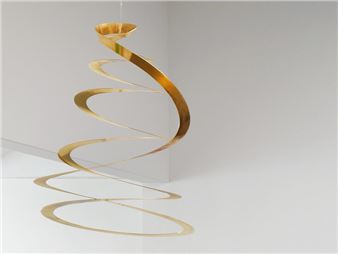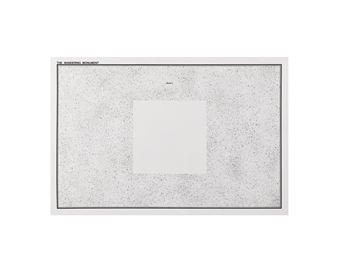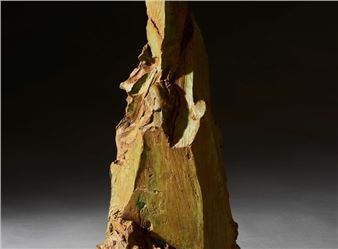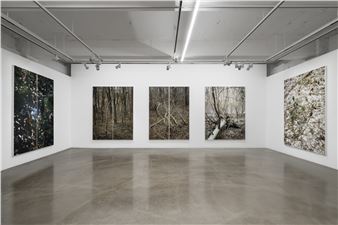Lygia Pape
White Cube Seoul is pleased to present an exhibition of works by Brazilian artist Lygia Pape (1927‚Äď2004), marking the gallery‚Äôs inaugural presentation of the artist and the first-ever presentation of her work in Seoul. A seminal figure in the Concrete art movement and a founding member of its splinter group, the Neo-Concrete movement, Lygia Pape played a defining role in in the development of contemporary art in Latin American. This exhibition traces the trajectory of Pape‚Äôs experimental five-decade career, showcasing some of the artist‚Äôs most renowned works across drawing, sculpture and installation, through which she pioneered new forms of geometric abstraction that questioned the spatial dynamics between artwork and viewer.
In the early 1950s, while studying at the Museu de Art do Rio de Janeiro, Pape, together with her artistic peers Alu√≠so Carv√£o, Lygia Clark and H√©lio Oiticica, formed the experimental collective Grupo Frente. Closely associated with the European Concrete movement, the group rejected the Brazilian modernist conventions of the era ‚Äď which tended towards the figurative ‚Äď instead engaging with a form of geometric abstraction untethered from observed reality. Pape‚Äôs wall-mounted series of ‚ÄėRelevos‚Äô (‚ÄėReliefs‚Äô) are emblematic of the artist‚Äôs early experimentations with constructivist forms, displaying an almost machine-made technical precision. Created with tempera and enamel paint on fibreboard, Relevo (1954-56) features four triads of elevated pyramidal forms, strategically arranged in the corners of the board. Each uniformly sized, the pyramids are hued a vivid orange on one ridge with a contrasting black on the opposing side. Hybridising the planar surface of the wooden canvas with projected three-dimensionality, the ‚ÄėRelevos‚Äô introduce a perceptive paradox ‚Äď the sequenced geometric forms are fused to a bidimensional plane, creating the illusion of floating independently within space.
Reiterating the linear elements and experimental arrangements of her ‚ÄėRelevos‚Äô, Pape began developing a series of drawings in ink titled ‚ÄėDesenhos‚Äô('Drawings‚Äô) during the latter 1950s and early ‚Äô60s ‚Äď a period marking the transition between her affiliation with Grupo Frente and her later commitment to Neo-Concrete values. The ‚ÄėDesenhos‚Äô thus exhibit composite qualities, combining the extreme rationalism of Concrete art with the ‚Äėexpressive potential‚Äô of its successor. In these drawings, precise linear trajectories intersect with impulsive stippled markings, giving rise to spherical and angular forms that convey a sense of kineticism. The striations collide, shift, weave and fracture one another with the spontaneity of sketched markings, setting the field in motion. This dynamic is at once evocative of the illusionistic optical effects of Op Art as well as the fluctuations found in musical compositions ‚Äď with parallel lines eliciting musical staves and negative areas marking caesuras within soundless orchestrations.
Pape‚Äôs pivotal role in the Brazilian Neo-Concrete movement in 1959 signalled a shift in her artistic practice, shaped by a liberation from static form and a move towards heightened sensuality through the interaction of objects in real-time and space. Livro Noite e Dia (Book of Night and Day) (1963‚Äď76) is one of Pape‚Äôs renowned series of part-book-part-sculptural works where the artist combines methods of painting, relief and bookmaking to chronicle temporality. Comprising 365 singular wooden units, Livro Noite e Dia records the shifting passage of light over the course of a year ‚Äď the units, carved individually from square boards with each segment reattached to their corresponding square, are arranged orthogonally and painted in monochromatic shades of black, white and grey, collectively forming a linear measure of time. Coinciding with her involvement with the film group Cinema Novo, the components of Livro Noite e Dia could equally be reworked as granular units, fragmented or cut, akin to the process of editing a film, with each individual part representing a single frame in a movie.
Following the disbandment of the Neo-Concrete movement in the early 1960s, Pape continued her explorations with basic forms ‚Äď those of the circle, the triangle and the square. Part of a series of geometric sculptures which utilises the square as a structural foundation, KV256 (1961‚Äď98) arose from the artist‚Äôs contemplations on the reconfigurable units found in the ‚ÄėLivro‚Äô series. Constructed from loose chrome-plated iron sections that have been cut and re-inserted, KV256 re-orders geometric elements to build and dismantle the square base shape. The detachable elements afford endless possibilities, facilitating the reconfiguration of the work into myriad arrangements ‚Äďpositioned next to, in front of, behind, or on top of the work. Manipulating metal with suppleness, the sculpture transcends the weight of its industrial composition to embody both geometric abstraction and organic fluidity. The reflective chrome surface interacts with shifting directional light, creating a work that occupies the intersection of solid and voided space, the material and metaphysical.
In the latter decades of her career, Pape devoted herself to exploring the interstices within and around geometric forms, establishing a dialogue between the cerebral and the intuitive. Belonging to her sculptural series, ‚ÄėVolante‚Äô, which translates as ‚Äėsteering wheel‚Äô or ‚Äėflying‚Äô, Pape‚Äôs 1999 sculpture features copper-plated iron wheels seemingly poised between stillness and motion. Pape termed this threshold dimension ‚Äėmagnetised space‚Äô, a conceptual framework that saw volume as inextricable from space, which she perceived to be interwoven through an ‚Äėendless skein‚Äô, applicable to the multifarious interconnectivity of the urban fabric, the relationship of the body to space, the viewer to the artwork.
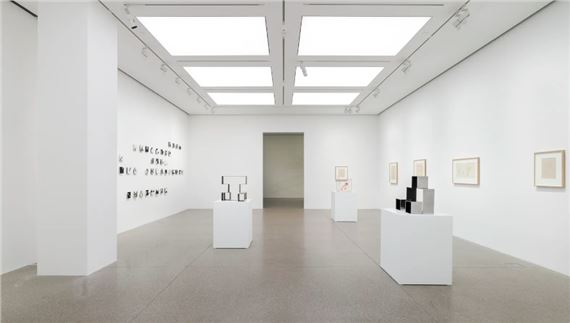
Recommended for you
White Cube Seoul is pleased to present an exhibition of works by Brazilian artist Lygia Pape (1927‚Äď2004), marking the gallery‚Äôs inaugural presentation of the artist and the first-ever presentation of her work in Seoul. A seminal figure in the Concrete art movement and a founding member of its splinter group, the Neo-Concrete movement, Lygia Pape played a defining role in in the development of contemporary art in Latin American. This exhibition traces the trajectory of Pape‚Äôs experimental five-decade career, showcasing some of the artist‚Äôs most renowned works across drawing, sculpture and installation, through which she pioneered new forms of geometric abstraction that questioned the spatial dynamics between artwork and viewer.
In the early 1950s, while studying at the Museu de Art do Rio de Janeiro, Pape, together with her artistic peers Alu√≠so Carv√£o, Lygia Clark and H√©lio Oiticica, formed the experimental collective Grupo Frente. Closely associated with the European Concrete movement, the group rejected the Brazilian modernist conventions of the era ‚Äď which tended towards the figurative ‚Äď instead engaging with a form of geometric abstraction untethered from observed reality. Pape‚Äôs wall-mounted series of ‚ÄėRelevos‚Äô (‚ÄėReliefs‚Äô) are emblematic of the artist‚Äôs early experimentations with constructivist forms, displaying an almost machine-made technical precision. Created with tempera and enamel paint on fibreboard, Relevo (1954-56) features four triads of elevated pyramidal forms, strategically arranged in the corners of the board. Each uniformly sized, the pyramids are hued a vivid orange on one ridge with a contrasting black on the opposing side. Hybridising the planar surface of the wooden canvas with projected three-dimensionality, the ‚ÄėRelevos‚Äô introduce a perceptive paradox ‚Äď the sequenced geometric forms are fused to a bidimensional plane, creating the illusion of floating independently within space.
Reiterating the linear elements and experimental arrangements of her ‚ÄėRelevos‚Äô, Pape began developing a series of drawings in ink titled ‚ÄėDesenhos‚Äô('Drawings‚Äô) during the latter 1950s and early ‚Äô60s ‚Äď a period marking the transition between her affiliation with Grupo Frente and her later commitment to Neo-Concrete values. The ‚ÄėDesenhos‚Äô thus exhibit composite qualities, combining the extreme rationalism of Concrete art with the ‚Äėexpressive potential‚Äô of its successor. In these drawings, precise linear trajectories intersect with impulsive stippled markings, giving rise to spherical and angular forms that convey a sense of kineticism. The striations collide, shift, weave and fracture one another with the spontaneity of sketched markings, setting the field in motion. This dynamic is at once evocative of the illusionistic optical effects of Op Art as well as the fluctuations found in musical compositions ‚Äď with parallel lines eliciting musical staves and negative areas marking caesuras within soundless orchestrations.
Pape‚Äôs pivotal role in the Brazilian Neo-Concrete movement in 1959 signalled a shift in her artistic practice, shaped by a liberation from static form and a move towards heightened sensuality through the interaction of objects in real-time and space. Livro Noite e Dia (Book of Night and Day) (1963‚Äď76) is one of Pape‚Äôs renowned series of part-book-part-sculptural works where the artist combines methods of painting, relief and bookmaking to chronicle temporality. Comprising 365 singular wooden units, Livro Noite e Dia records the shifting passage of light over the course of a year ‚Äď the units, carved individually from square boards with each segment reattached to their corresponding square, are arranged orthogonally and painted in monochromatic shades of black, white and grey, collectively forming a linear measure of time. Coinciding with her involvement with the film group Cinema Novo, the components of Livro Noite e Dia could equally be reworked as granular units, fragmented or cut, akin to the process of editing a film, with each individual part representing a single frame in a movie.
Following the disbandment of the Neo-Concrete movement in the early 1960s, Pape continued her explorations with basic forms ‚Äď those of the circle, the triangle and the square. Part of a series of geometric sculptures which utilises the square as a structural foundation, KV256 (1961‚Äď98) arose from the artist‚Äôs contemplations on the reconfigurable units found in the ‚ÄėLivro‚Äô series. Constructed from loose chrome-plated iron sections that have been cut and re-inserted, KV256 re-orders geometric elements to build and dismantle the square base shape. The detachable elements afford endless possibilities, facilitating the reconfiguration of the work into myriad arrangements ‚Äďpositioned next to, in front of, behind, or on top of the work. Manipulating metal with suppleness, the sculpture transcends the weight of its industrial composition to embody both geometric abstraction and organic fluidity. The reflective chrome surface interacts with shifting directional light, creating a work that occupies the intersection of solid and voided space, the material and metaphysical.
In the latter decades of her career, Pape devoted herself to exploring the interstices within and around geometric forms, establishing a dialogue between the cerebral and the intuitive. Belonging to her sculptural series, ‚ÄėVolante‚Äô, which translates as ‚Äėsteering wheel‚Äô or ‚Äėflying‚Äô, Pape‚Äôs 1999 sculpture features copper-plated iron wheels seemingly poised between stillness and motion. Pape termed this threshold dimension ‚Äėmagnetised space‚Äô, a conceptual framework that saw volume as inextricable from space, which she perceived to be interwoven through an ‚Äėendless skein‚Äô, applicable to the multifarious interconnectivity of the urban fabric, the relationship of the body to space, the viewer to the artwork.
Artists on show
Contact details

Related articles
White Cube is presenting the first solo exhibition in Asia of pioneering Brazilian artist Lygia Pape (1927‚Äď2004), opening in Seoul in March 2024.
Although she may not yet be familiar to audiences in Asia, the late Brazilian artist Lygia Pape (1927-2000) is known as a pioneering contemporary artist in Latin America and one of the leading figures who founded the Neo-Concrete Movement in the region.
Mirrors have been used in art for a long time. One early example comes from poet Giovanni Boccaccio’s (1313-1375) treatise, De Mulieribus Claris (Concerning Famous Women, 1374).

 ARTISTS
ARTISTS








